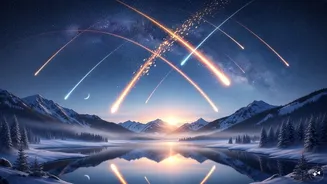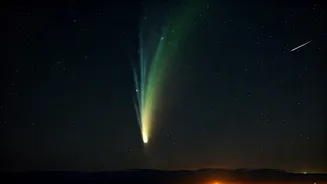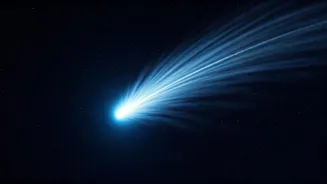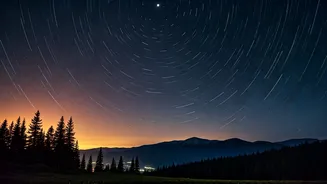What is the story about?
Stargazers across the United States are in for a celestial spectacle tonight as the Orionid meteor shower reaches its peak, sending up to 20 meteors per hour streaking across the sky. The dazzling display, created by debris from Halley’s Comet, promises a memorable show for skywatchers from coast to coast.
The 2025 Orionid meteor shower will peak on the night of Monday, October 20, continuing into the early hours of Tuesday, October 21.
For the best view, head outdoors after midnight until dawn, when the radiant point, the spot in the sky where the meteors appear to originate, climbs highest. Observers under clear, dark skies can expect to see an average of 10 to 20 meteors per hour.
The Orionids are best viewed with the naked eye, no telescope needed. Simply look toward the eastern sky, where the constellation Orion will rise and move toward the south-southeast before sunrise.
If you’re looking for the best places to catch the meteor shower, head to areas far from city lights. Here are a few top spots across the US offering ideal conditions:
Joshua Tree National Park, California
As an International Dark Sky Park, Joshua Tree’s vast desert landscapes and crystal-clear skies make it one of the best places in the country to see the Milky Way—and tonight, the Orionids.
Anza-Borrego Desert State Park, California
Designated both a Dark Sky Community and State Park, Anza-Borrego provides some of Southern California’s darkest skies, perfect for meteor watching and casual stargazing.
Cherry Springs State Park, Pennsylvania
Known as the darkest spot on the East Coast, Cherry Springs offers 360-degree views of the night sky, making it a prime location for spotting meteors, planets, and even the glowing band of the Milky Way.
Keep an eye on the night sky in October—you might catch a falling star!
The Orionid meteor shower reaches its peak on the night of Oct. 21-22, and the Draconids will also be visible earlier in the month. Check out what else to watch out for: pic.twitter.com/JlRSzHUlbA
— NASA (@NASA) September 30, 2025
When to watch
The 2025 Orionid meteor shower will peak on the night of Monday, October 20, continuing into the early hours of Tuesday, October 21.
For the best view, head outdoors after midnight until dawn, when the radiant point, the spot in the sky where the meteors appear to originate, climbs highest. Observers under clear, dark skies can expect to see an average of 10 to 20 meteors per hour.
The Orionids are best viewed with the naked eye, no telescope needed. Simply look toward the eastern sky, where the constellation Orion will rise and move toward the south-southeast before sunrise.
Where to watch
If you’re looking for the best places to catch the meteor shower, head to areas far from city lights. Here are a few top spots across the US offering ideal conditions:
Joshua Tree National Park, California
As an International Dark Sky Park, Joshua Tree’s vast desert landscapes and crystal-clear skies make it one of the best places in the country to see the Milky Way—and tonight, the Orionids.
Anza-Borrego Desert State Park, California
Designated both a Dark Sky Community and State Park, Anza-Borrego provides some of Southern California’s darkest skies, perfect for meteor watching and casual stargazing.
Cherry Springs State Park, Pennsylvania
Known as the darkest spot on the East Coast, Cherry Springs offers 360-degree views of the night sky, making it a prime location for spotting meteors, planets, and even the glowing band of the Milky Way.
Do you find this article useful?

















